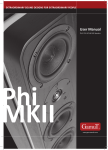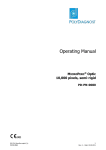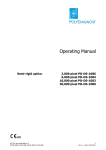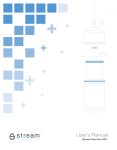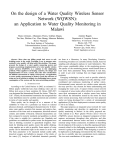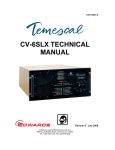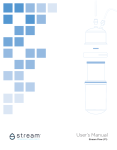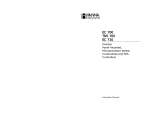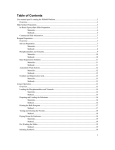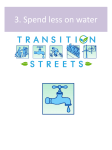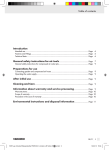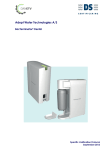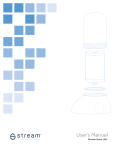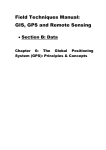Download 2015 CCR - Corona Department of Water & Power
Transcript
Consumer Confidence Report 2015 For the year 2014 CITY of CORONA Department of Water and Power “Protecting Public Health” Message from the General Manager T he City of Corona Department of Water and Power (DWP) has been working over the years to reduce our water use by developing a reclaimed water system, an active water conservation program, ensuring sustainability through developing relationships within our region and increasing our local water supplies. We are proud of our efforts and the community’s for working over the years to reduce our water use, but we are now called on by the Governor and fellow Californians who need us to do more. Corona has been required by the SWRCB to reduce our water use by 28%. Since most indoor water use cannot be reduced, we must look outdoors to provide us with the savings needed. 2 In response to the Governor’s Executive Order, in May the DWP announced that we will go to Stage 3 of our Water Conservation Ordinance. Stage 3 requires 3 days per week watering, with 10 minutes maximum per station. The goal is to reduce outdoor water use by 50%. We know that the coming months will be tough for everyone as the State grapples with its water problems and temperatures increase. But we know that together as a community, we will do what is necessary to meet those requirements. DWP is here to help with programs and incentives to reduce both indoor and outdoor water use. I am proud to provide this annual report to you. It lists the types and amounts of key elements in your water supply, their likely sources and the maximum contaminant level (MCL) that the United States Environmental Protection Agency considers safe. We utilize a multi-barrier treatment process to assure safe drinking water is delivered to your home or business. Information contained in this report includes both required statistics and other information on water quality to provide you with the tools you need to make informed choices about the water you drink. This report not only reflects our ability to meet and exceed health standards, it also demonstrates our commitment to you and our community that we will always provide you with the best product and service that we can offer. I invite you to please contact me with any questions on this report or if you require additional information. Jonathan Daly General Manager 951-736-2477 www.CoronaDWP.org Consumer Confidence Report 2015 (for year 2014) Exceeding Standards Water Treatment Processes Last year, as in years past, your tap water met all United States Environmental Protection Agency (USEPA) and State drinking water health standards. The City of Corona safeguards its water supplies, and we are proud to report that our system has not violated any primary drinking water standard. The water from the Colorado River requires treatment to remove and inactivate harmful organisms. This process is accomplished using the City of Corona’s two surface water treatment facilities: the Sierra Del Oro and Lester Water Treatment Facilities. These facilities incorporate the use of coagulants, which bind small particles together to form larger particles that can be easily removed through multimedia filtration and disinfection. Through independent laboratory testing, 100% of the samples taken in 2014 were free of harmful organisms. This report is a snapshot of the water quality in 2014. Included are details about where your water comes from, what it contains, and how it compares to the State’s standards. Corona’s Water Sources About half of the groundwater pumped in Corona is sent through a state-of-the-art reverse osmosis membrane treatment facility, the Temescal Desalter. This facility incorporates nitrate and Total Dissolved Solids (TDS) removal, and also provides disinfection. In 2014, Corona residents and businesses used approximately 12.5 billion gallons of drinking water. Corona’s water supply comes from three main sources: local groundwater supplies, the Colorado River and the State Water Project in Northern The Department of Water and Power disinfects Lester Treatment Plant California. Groundwater wells owned and operated the distribution system with monochloramines (a by the City of Corona provided 57.4% of our water supply, with another ratio of chlorine and ammonia). This allows us to achieve a long-lasting 35.4% coming through Lake Mathews from the Colorado River, 4% is chlorine residual and reduce the production of disinfection byproducts. from the State Water Project’s California Aqueduct and the final 3.2% is Disinfection byproducts are formed when disinfectants (i.e. chlorine and purchased from Western Municipal Water District’s Arlington Desalter monochloramines) react with naturally occurring organic matter in water. treatment facility. 3 www.CoronaDWP.org Blending Governor Brown’s Executive Order B-29-15 The Department of Water and Power has five active blending facilities that blend water with low nitrate, fluoride, perchlorate and Total Dissolved Solids with the remaining groundwater sources to deliver safe, reliable drinking water to your tap. After viewing the non-existent snowpack in the Sierra Nevada mountains earlier this year, Governor Brown issued Executive Order B-29-15. This executive order mandated a net 25% statewide reduction in potable, or drinking, water use from 2013 water usage. Governor Brown’s executive order can be found online at http://gov.ca.gov/docs/4.1.15_ Executive_Order.pdf. You will notice in the tables of detected contaminants that the groundwater exceeds the primary standard for fluoride, nitrate and perchlorate. The Department of Water and Power is required by law to report the range of all samples monitored, as well as the average concentration delivered to your tap. The averages of what you receive at your tap are much lower because the Department of Water and Power treats and blends water from several sources to meet water quality standards. The blending stations are continuously monitored and routinely sampled to ensure that the water delivered to your tap meets all health standards with a safety margin of no less than 10%. Please refer to the “Treated Average System Water” column in the tables at the end of the report for a more accurate representation of system water quality. For more information about fluoridation, oral health, and current issues visit: http://www.waterboards.ca.gov/drinking_water/certlic/ drinkingwater/Fluoridation.shtml. Governor Brown’s executive order contained many prohibitions on water use. Watering turf medians with potable water is restricted. All new homes must have drip or subterranean irrigation – no overhead spray heads are allowed. Watering within 48 hours of measurable rainfall is prohibited. Agencies or individuals that do not do their part to reduce water use will be fined or otherwise penalized. The Governor called on the State Water Resources Control Board, or SWRCB, to implement and oversee the water reduction mandates. The SWRCB created eight different tiers of water reduction, ranging from 4% to 36%. They put each water agency in a tier based on their water usage from June through September 2014. Despite Corona’s past conservation efforts and a robust reclaimed water system, Corona’s conservation target tier is a 28% reduction from our water use in 2013. A 28% reduction is a staggering amount for Corona at nearly 2.2 billion gallons of water. Since most indoor water use is essential for health and safety, the Governor’s message is clear: reduce outdoor watering. 4 Consumer Confidence Report 2015 (for year 2014) What is Corona Doing About the Governor’s Mandate? The City of Corona Department of Water and Power (DWP) thanks everyone for their overwhelming participation in conservation over the past several years. While those conservation efforts have not gone unnoticed, the City is still responsible for ensuring that we comply with the SWRCB’s mandated reduction. Therefore, in response to the SWRCB’s determination, the DWP is taking the following actions: • Enacting Stage 3 of our Water Conservation Ordinance, calling for a 50% reduction in outdoor watering. • Accelerated Turf Removal Projects, including increasing the residential rebate to $3 per square foot of turf removed, with a maximum of 3,000 square feet removed. • Accelerated Reclaimed Water Conversions • Reducing the outdoor water budget for landscapes by 50% • Reassigning staff to assist our customers with landscape check-ups • Turf disposal days at City facilities • Sponsoring community projects to help those who cannot remove turf themselves • Utilizing the California Conservation Corps to help remove turf from City parkways • Partnerships with the Corona Norco Unified School District • Free installation of high-efficiency sprinkler nozzles • Rebates on high-efficiency toilets, pool covers, sprinkler timers and recirculating pumps Stage 3 Water Conservation Ordinance Stage 3 of Corona’s Water Conservation Ordinance requires the following: • No watering between 10 a.m. and 8 p.m. • Odd numbered addresses can water on Saturday, Monday and Wednesday only. • Even numbered addresses can water on Sunday, Tuesday and Thursday only. • Watering on Fridays is prohibited. Since government institutions are not open on weekends, they may water three days per week of the agency’s choosing. • Sprinkler times are limited to 10 minutes maximum per station per watering day. You can have two cycles of five minutes a day, which can also help reduce runoff. • Drip irrigation, which waters in gallons per hour, can water for a maximum of 90 minutes per day, provided there is no runoff. • Watering during and within 48 hours after rainfall measuring ½” or more is prohibited. 5 www.CoronaDWP.org Cash For Grass • Leaks and broken sprinklers must be fixed in a timely manner. • Water cannot be allowed to runoff property. While we may not like or agree with the Governor’s mandate, the facts • Washing hard surfaces is prohibited. about outdoor water use are staggering. For example, did you know that • Vehicles can only be washed using a bucket and hose with an automatic about 60 – 70% of your annual water use is used outside your home? shut-off nozzle. • Food establishments are prohibited from providing drinking water to patrons unless requested. • The overfilling of swimming pools and spas is prohibited. The filling or refilling of ornamental ponds, streams and artificial lakes is prohibited. operation of any ornamental fountain or similar structure is prohibited except for short periods of time to prevent damage, unless the fountain is recirculating. • The What Can We Expect? A 28% reduction in water use is a lot. These mandates will have a definite impact on the City and the way it looks. Watering three days per week at a maximum of 10 minutes per station may cause your lawn stress. Many lawns will turn yellow. There will be increased activities by the DWP to help both individuals and businesses set their watering schedule to comply with Stage 3 requirements. You may receive a notification regarding a leak, water running off your property or watering outside the watering days and times. If you do, it is important to address the issue promptly. Corona receives only about 12 inches of rain in an average year. As a comparison, Las Vegas receives about 4 inches of rain per year; we are not that far off. Grass needs around 52 inches of water a year to live in our climate. That means that we are applying 40 inches of water, or more, to help grass survive in our semi-arid landscape. Removing some grass can dramatically reduce your water use and also beautify your landscape. Think about removing small areas of grass if you don’t want to completely remove your turf – make an existing planter larger, or remove the grass in your parkway. The Water Resources Team makes this easy for you through the Cash for Grass Rebate Program. Front yard, parkway and backyard projects are eligible to receive a rebate of $3 per square foot of grass replaced with a maximum of 3,000 square feet. Artificial turf is also eligible for the rebate. Visit www.CoronaDWP.org/res-rebates for the full Cash for Grass rebate application and guidelines. 6 Consumer Confidence Report 2015 (for year 2014) We Are In This Together, and We Are Here To Help! This summer is sure to be challenging. Restrictions of any kind cause tension, and the summer heat will only add to the situation. We want to remind the community that DWP is here to help everyone get through these issues. Our goal is to first provide help to residents and businesses to meet these mandates. We’re the experts on water, so let us help you. We offer a variety of programs, including rebates for high-efficiency appliances, free sprinkler nozzles and devices, landscape check-ups and more. Just give our Water Resources Team a call at 951-736-2234 to find out more on how you can help do your part to reach this target. At a cost of less than a penny a gallon, the real value of water is not represented in the price that we pay for it. Water is a precious resource; we all need it to live. The current drought situation in California has proven that water availability is not guaranteed. A water supply can be highly variable, with many factors that affect it, including drought, legislative restrictions, water quality issues and environmental needs. We must always use our resources efficiently, and focus on sustainable water supplies. Make every drop count – use water efficiently always. Tour Our Facilities – In Person or On the Web! A lot goes on behind the scenes to provide our customers with clean and affordable drinking Water: An Undervalued Resource water. Do you want to learn more about how your water is treated and delivered? Are you Earth is called the blue planet because most of interested in seeing how we produce reclaimed See how your water is treated and delivered by attending a its surface is covered with water. Yet only 3% of quarterly facility tour. water? If you have any questions about our water the earths’ water is fresh water that is used for supply or water reclamation facilities, or you’re drinking, with 2/3 stored in ice caps and glaciers. That’s a small amount just curious, we encourage you to attend one of our quarterly facility of water for everyone on the planet to share. Yet many of us don’t think tours. Visit our website at www.CoronaDWP.org to be put on an interest twice about the water that we use every day. All too often, water that has list for future tours, or contact our Water Resources Team at 951-736-2234 been pumped in from afar and treated for human consumption can be or by e-mail at [email protected] to sign up for an seen running down the storm drains – wasted. 7 www.CoronaDWP.org upcoming tour. You must be at least 18 years old and a customer of the Department of Water and Power to attend. Don’t have the spare time to come on a tour? The Department of Water and Power has created 11 new videos of our facilities and services for you to watch from the convenience of your home computer or tablet. Simply go to our website at www.CoronaDWP.org. Reclaimed Water To improve water supply reliability for the City, the Department of Water and Power developed and built our reclaimed water system in 2006. Utilizing reclaimed water to help meet water demands for the City reduces the impact of imported water supply shortages and costs. The reclaimed water system uses highly treated wastewater from our state-of-the-art water reclamation facilities and distributes it throughout the reclaimed water system. The reclaimed system is completely separate from the drinking water system, utilizing a purple pipe system and sprinkler caps and signage to denote its location. Reclaimed water is used primarily on landscaping at parks, schools and parkway areas, and even in a commercial building. By re-using water that would normally have been wasted, we save potable water for our homes and businesses. The City of Corona’s infrastructure for the reclaimed water system consists of approximately 47 miles of pipeline, three storage tanks, and four pump stations. The reclaimed water system produced 2.25 billion gallons of reclaimed water in 2014. We currently have 286 connections, and are continually adding new sites. Did You know? • There are 748 gallons of water in one unit of water. • One acre-foot of water equals 325,829 gallons or 435.6 billing units. • One acre-foot of water can supply two typical families with water for a whole year. • A leaky toilet can waste between 30 to 500 gallons of water per day. From Your Drain to the Environment – Keep it Clean While water reclamation treatment removes most pollutants, even trace amounts of some substances may be harmful to the environment. The best solution is to prevent pollution from going down the drain in the first place. 8 Consumer Confidence Report 2015 (for year 2014) Dispose of unwanted medicine properly… No Drugs Down the Drain! For years, unwanted medicine was flushed down the drain to protect children and pets from accessing it, and to ensure against illegal recovery of controlled substances. Today, there are better options. The City of Corona Department of Water and Power and the Police Department are working together to protect our environment from the harmful effects of improperly discarded, unused medications. For your convenience, a pharmaceutical disposal bin has been placed at the Corona Police Department lobby located at 730 Public Safety Way. For more information, please call 951-736-2330. Keep drains free of FOG – Fats, Oils and Grease When washed down the drain, cooking fats, oils and grease, or “FOG,” can block sewer lines, causing raw sewage to back up into your home or into neighborhood streets and storm drains. Overflows can be costly, and pose health and environmental hazards. Keep your sewer lines FOGfree by scraping cooking fats into the garbage or into your food scrap recycling bin, where available – not down the drain. A Note About Water Quality Monitoring in 2014 We are required to monitor your drinking water for specific contaminants on a regular basis. Results of regular monitoring indicate whether or not our drinking water meets health standards. During August 2014, we did not complete all monitoring or testing for total coliform, and therefore cannot be sure of the quality of your drinking water at that time. Due to a miscommunication/error from the laboratory, the City collected repeat samples at a different location than required. Subsequent samples taken at the correct locations met the health standards. The City has taken the necessary actions with our laboratory to prevent this issue from occurring again. General Water Quality Information The sources of drinking water (both tap and bottled water) include rivers, lakes, streams, ponds, reservoirs, springs, and wells. As water travels over the surface of the land or through the ground, it dissolves naturally-occurring minerals and, in some cases, radioactive material, and can pick up substances resulting from the presence of animals or from human activity. 9 www.CoronaDWP.org Contaminants that may be present in source water include: • Microbial contaminants, such as viruses and bacteria, that may come from sewage treatment plants, septic systems, agricultural livestock operations, and wildlife. • Inorganic contaminants, such as salts and metals, that can be naturallyoccurring or result from urban stormwater runoff, industrial or domestic wastewater discharges, oil and gas production, mining or farming. • Pesticides and herbicides, that may come from a variety of sources such as agriculture, urban stormwater runoff, and residential uses. (State Board) prescribe regulations that limit the amount of certain contaminants in water provided by public water systems. State Board regulations also establish limits for contaminants in bottled water that provide the same protection for public health. Drinking water, including bottled water, may reasonably be expected to contain at least small amounts of some contaminants. The presence of contaminants does not necessarily indicate that water poses a health risk. More information about contaminants and potential health effects can be obtained by calling the USEPA’s Safe Drinking Water Hotline (1-800-426-4791). Some people may be more vulnerable to contaminants in drinking water than the general population. Immuno-compromised persons such as persons and volatile organic chemicals that are byproducts of with cancer undergoing chemotherapy, persons who industrial processes and petroleum production, and have undergone organ transplants, people with HIV/ can also come from gas stations, urban stormwater AIDS or other immune system disorders, some elderly, runoff, agricultural application and septic systems. 100% of the samples taken in 2014 were free from harmful organisms. and infants can be particularly at risk from infections. • Radioactive contaminants, that can be naturallyThese people should seek advice about drinking occurring or be the result of oil and gas production and mining water from their health care providers. USEPA/Centers for Disease Control activities. (CDC) guidelines on appropriate means to lessen the risk of infection by In order to ensure that tap water is safe to drink, the U.S. Environmental Cryptosporidium and other microbial contaminants are available from Protection Agency (USEPA) and the State Water Resources Control Board the Safe Drinking Water Hotline (1-800-426-4791). • Organic chemical contaminants, including synthetic 10 Consumer Confidence Report 2015 (for year 2014) Nitrate Nitrate in drinking water at levels above 45 mg/L is a health risk for infants of less than six months of age. Such nitrate levels in drinking water can interfere with the capacity of the infant’s blood to carry oxygen, resulting in a serious illness; symptoms include shortness of breath and blueness of the skin. Nitrate levels above 45 mg/L may also affect the ability of the blood to carry oxygen in other individuals, such as pregnant women and those with certain specific enzyme deficiencies. If you are caring for an infant, or you are pregnant, you should ask advice from your health care provider. Source Water Assessment In accordance with the Federal Safe Drinking Water Act (SDWA), the State Water Resources Control Board Division of Drinking Water and Environmental Management developed a program, called the Drinking Water Source Assessment and Protection (DWSAP) Program, to assess the vulnerability of drinking water sources to contamination. Assessments of the drinking water sources for the City of Corona were completed most recently in February 2012. The assessment concluded that the City of Corona’s sources are considered most vulnerable to the following activities not associated with any detected contaminants in the water supply: automobile – gas stations, chemical/petroleum pipelines, chemical/petroleum processing/storage, dry cleaners, historic gas stations, machine shops, metal plating/finishing/fabricating, mining – sand/gravel, NPDES/WDR permitted discharges, plastics/synthetics producers, septic systems – low density [<1/acre], sewer collection systems, underground storage tanks – confirmed leaking tanks, utility stations – maintenance areas, and wastewater treatment plants. A copy of the complete assessments are available through the City of Corona’s City Clerk’s office at 400 S. Vicentia, Corona, CA 92882, or by using the online Public Records Request form at www.CoronaDWP.org. Lead and Copper Rule Monitoring The Lead and Copper Rule (LCR) was developed to protect public health by minimizing lead and copper levels in drinking water. The LCR established an action level of 15 parts per billion (ppb) for lead and 1.3 parts per million (ppm) for copper based on the 90th percentile level of tap water samples collected. Lead and copper are sampled on a mandated three year testing cycle with sampling conducted at the customer’s tap. Parameter Units State MCL PHG State DLR Date Sampled 90th Percentile No. Sites Sampled No. Sites Exceeding AL Lead ppb AL=15 0.2 5 2014 2 50 0 Copper ppm AL=1.3 0.3 0.05 2014 0.11 50 0 AL Action Level DLR Detection Limits for purposes of Reporting Maximum Contaminant Level MCL PHG Public Health Goal ppb Parts per billion or micrograms per liter (μg/L) ppm Parts per million or milligrams per liter (mg/L) 11 www.CoronaDWP.org Please see pages 19-21 for key to abbreviations and footnotes Primary Standards – Mandatory Health-Related Standards Parameter Units State MCL [MRDL] Combined Filter Effluent Turbidity NTU TT 0.3 % 95(a) Combined Filter Effluent Turbidity NTU TT 0.3 % 95(a) Parameter Units PHG (MCLG) [MRDLG] State DLR NA – NA – State MCL [MRDL] PHG (MCLG) [MRDLG] State DLR Range Average Regulated in Distribution System Major Sources in Drinking Water Range Average Water Source Major Sources in Drinking Water CLARITY Highest Highest % < 0.3 0.09 Metropolitan Water District Henry J. Mills Water Treatment Plant 100% City of Corona, Lester & Sierra Del Oro Water Treatment Facilities 100% % < 0.3 0.17 Soil runoff Soil runoff MICROBIOLOGICAL CONTAMINANTS Total Coliform Bacteria (Total Coliform Rule) % 5.0 (b) (0) – – Highest % of positive samples collected in any one month = 2% Naturally present in the environment Fecal Coliform and E. Coli (Total Coliform Rule) (c) (c) (0) – – Total number of positive samples collected in 2014 = 0 Human and animal fecal waste TT NA NA Range Distribution System Wide: ND-1200 Average Distribution System Wide: 4 State MCL [MRDL] PHG (MCLG) [MRDLG] State DLR Heterotrophic Plate Count CFU/mL (HPC) Parameter Units Range Average State Project Water Colorado River Water Arlington Desalter Ground Water Naturally present in the environment Treated Average System Water Major Sources in Drinking Water RADIOACTIVE CONTAMINANTS (j) Gross Alpha Particle Activity (k) pCi/L 15 (0) 3 Uranium pCi/L 20 0.43 1 Range ND-4 ND-4 2.4 ND-11 – Average ND 3 2.4 5.8 – Range ND-4 2-3 2.63 ND-15 – Average ND 3 2.63 7.5 – Erosion of natural deposits Erosion of natural deposits 12 Consumer Confidence Report 2015 (for year 2014) Primary Standards –(continued) Units State MCL [MRDL] PHG (MCLG) [MRDLG] State DLR Arsenic ppb 10 0.004 2 Barium ppm 1 2 0.1 Fluoride (e, h) ppm 2 1 0.1 Hexavalent Chromium ppb 10 0.02 1 Parameter Range Average State Project Water Colorado River Water Arlington Desalter Ground Water Treated Average System Water Range Average Range Average ND ND ND ND 2.2 2.2 0.11 0.11 ND ND ND ND ND-7.2 2.1 ND-0.34 ND ND-2 ND ND ND Erosion of natural deposits; runoff from orchards; glass and electronics production wastes Range 0.7-1.0 0.3 ND-0.1 ND-2.9 ND-0.83 Average 0.8 0.3 ND 0.4 0.25 Erosion of natural deposits; water additive that promotes strong teeth; discharge from fertilizer and aluminum factories Range ND ND – ND-5 ND Average ND ND – ND ND Range Average Range ND ND ND ND ND ND ND ND 14-23 ND-12 ND ND-97 ND ND ND-34 Average ND ND 19 40 19 Range ND ND ND ND-12 ND Average ND ND ND ND ND Range ND ND ND ND-10 ND Average ND ND ND ND ND Major Sources in Drinking Water INORGANIC CONTAMINANTS Nickel ppb 100 12 10 Nitrate (as N03) (d,e,k) ppm 45 45 2 Perchlorate (e, i, k) Selenium ppb ppb 6 50 6 30 4 5 Discharges of oil drilling wastes and from metal refineries; erosion of natural deposits Discharge from electroplating factories, leather tanneries, wood preservation, chemical synthesis, refractory production, and textile manufacturing facilities; erosion of natural deposits Erosion of natural deposits; discharge from metal factories Runoff and leaching from fertilizer use; leaching from septic tanks and sewage; erosion of natural deposits Perchlorate is an inorganic chemical used in solid rocket propellant, fireworks, explosives, flares, matches, and a variety of industries. It usually gets into drinking water as a result of environmental contamination from historic aerospace or other industrial operations that used or use, store, or dispose of perchlorate and its salts. Discharge from petroleum, glass, and metal refineries; erosion of natural deposits; discharge from mines and chemical manufacturers; runoff from livestock lots (feed additive) 13 www.CoronaDWP.org Primary Standards –(continued) Parameter Units State MCL [MRDL] PHG (MCLG) [MRDLG] State DLR Range Average State Project Water Colorado River Water Arlington Desalter Ground Water Treated Average System Water Range ND ND ND ND-28 ND Average ND ND ND ND ND Range Average Range Average ND ND ND ND ND ND ND ND ND ND ND ND ND-0.72 ND ND-1.7 0.6 ND ND ND ND Discharge from factories, dry cleaners, and auto shops (metal degreaser) Range Max RAA Range Average Range Average Range Average Range Average ND-190 117 94-97 96 1 1 11.9-12 12 ND ND ND ND 82-88 85 2 2 – – ND ND ND ND 30-41 37 ND ND – – – – ND ND ND-250 132 ND-5 ND 5.8-13 12 ND-100 6.9 ND-390 377 23-90 65 ND-3 1 9.9-13 11.8 ND ND Erosion of natural deposits; residual from some surface water treatment processes Major Sources in Drinking Water SYNTHETIC ORGANIC CONTAMINANTS including Pesticides/PCBs Dibromochloropropane (DBCP) ppt 200 1.7 10 Banned nematocide that may still be present in soils due to runoff/leaching from former use on soybeans, cotton, vineyards, tomatoes, and tree fruit VOLATILE ORGANIC CONTAMINANTS Tetrachloroethylene (PCE) ppb 5 0.06 0.5 Trichloroethylene (TCE) ppb 5 1.7 0.5 Discharge from metal degreasing sites and other factories SECONDARY STANDARDS – Aesthetic Standards Aluminum (u) ppb 200 600 50 Chloride ppm 500 NA NA Color Units 15 NA NA Corrosivity (as Aggressiveness Index) AI NA NA NA Foaming Agents (MBAS) ppb 500 NA NA Runoff/leaching from natural deposits; seawater influence Naturally-occurring organic materials Elemental balance in water; affected by temperature, other factors Municipal and industrial waste discharges 14 Consumer Confidence Report 2015 (for year 2014) Primary Standards –(continued) Parameter Units State MCL [MRDL] PHG (MCLG) [MRDLG] State DLR Range Average State Project Water Colorado River Water Arlington Desalter Ground Water Treated Average System Water Major Sources in Drinking Water SECONDARY STANDARDS – Aesthetic Standards Manganese (f, k) ppb 50 NL=500 20 Odor Threshold ppb 3 NA NA Specific Conductance (k) µS/ cm 1600 NA NA Sulfate ppm 500 NA 0.5 Total Dissolved Solids (e, k, t) ppm 1000 NA NA Turbidity Units 5 NA NA Range ND ND ND ND-820 ND Average ND ND ND 45 ND Range 2 8 ND ND-8 1 Average 2 8 ND 0.8 1 Range 618-623 922-961 332-570 3-2,100 210-980 Average 621 942 457 1,246 680 Range 62-65 220-231 36-50 ND-380 3-220 Average 64 226 43 185 113 Range 333-349 580-615 190-390 ND-1,400 100-680 Average 341 598 269 783 402 Range ND 0.87-2.7 ND 0.05-0.5 0.07-0.12 Average ND 1.8 ND 0.12 0.09 UNREGULATED CONTAMINANTS WITH NO MCLs (g) Boron (p) Vanadium ppm ppb NA NA Leaching from natural deposits Naturally-occurring organic materials Substances that form ions when in water; seawater influence Runoff/leaching from natural deposits; industrial wastes Runoff/leaching from natural deposits Soil runoff Health Effects NL=1 NL=50 Range 0.17 0.1 – 0.35-5.2 ND-1 Average 0.17 0.1 – 1.5 0.31 Range ND ND 4.1-6.1 ND-22 ND-3.4 Average ND ND 5 5.7 ND 0.1 3 The babies of some pregnant women who drink water containing boron in excess of the notification level may have an increased risk of developmental effects, based on studies in laboratory animals. The babies of some pregnant women who drink water containing vanadium in excess of the notification level may have an increased risk of developmental effects, based on studies in laboratory animals. 15 www.CoronaDWP.org Parameter Units State MCL [MRDL] PHG (MCLG) [MRDLG] State DLR Range Average Distribution System Range Average Range Average Range ND-0.14 0.04 75-360 152 ND-0.52 FEDERAL UNREGULATED CONTAMINANTS MONITORING RULE (UCMR3) (v) List 1 - Assessment Monitoring 1,4-Dioxane ppb NA NA 0.07 Chlorate ppb NA NA 20 Chromium ppb NA NA 0.2 Hexavalent Chromium (Dissolved) ppb NA NA 0.03 Molybdenum ppb NA NA 1 Strontium ppb NA NA 0.3 Vanadium ppb NA NA 0.2 Perfluoro octanesulfonic acid - PFOS ppb NA NA 0.04 Perfluorooctanoic acid - PFOA ppb NA NA 0.02 Perfluoroheptanoic acid PFHpA ppb NA NA 0.01 Average 0.103 Range ND-0.43 Average 0.134 Range Average Range Average Range Average Range Average Range Average Range Average ND-17 3.7 25-1100 589 ND-6.4 2.4 ND-0.046 0.007 ND-0.042 0.007 ND-0.013 0.002 Water-saving Tip: Install faucet aerators on your bath and kitchen sinks and save over 1,700 gallons a year. 16 Consumer Confidence Report 2015 (for year 2014) Other Parameters Chemical Units State MCL [MRDL] PHG (MCLG) [MRDLG] State DLR Alkalinity ppm NA NA NA Bicarbonate Calcium Carbonate Hardness ( r) ppm ppm ppm ppm Magnesium ppm pH pH Units Potassium Sodium (s) ppm ppm NA NA NA NA NA NA NA NA NA NA NA NA NA NA NA NA NA NA NA NA NA NA NA NA Range Average State Project Water Colorado River Water Arlington Desalter Ground Water Treated Average System Water 22-110 Range 86-90 132-133 65-150 ND-310 Average 88 133 91 196 67 Range – – 79-190 ND-380 26-140 Average – – 112 241 82 Range 26-28 71-74 28-35 ND-200 3-84 Average 27 73 32 113 45 Range – – – ND-4.9 ND-2 Average – – – 0.4 0.7 Range 120-122 282-290 110-140 ND-720 10-320 Average 121 286 128 410 168 Range 13 25-27 10-13 ND-77 0.72-28 Average 13 26 12 31 15 Range 8.1-8.3 8.3-8.4 7-8.7 6.3-12 7.3-9.1 Average 8.2 8.3 8.2 7.3 8 Range 3.1 4.4-4.7 ND-1.3 ND-13 1.2-5 Average 3.1 4.6 1 4.2 3.4 Range 72-78 84-91 36-41 ND-200 26-91 Average 75 88 38 103 65 Water-saving Tip: The typical person can use as much as 150 gallons of water to wash an average size car. Using a pail of soapy water to wash your vehicle and using the hose only for rinsing is a better alternative. 17 www.CoronaDWP.org 2015 Annual Water Quality Report for 2014 Parameter Units State MCL [MRDL] PHG (MCLG) [MRDLG] State DLR Range Average/ LRAA/RAA Distribution System Wide Major Sources in Drinking Water Health Effects Language DISINFECTION BYPRODUCTS, DISINFECTANT RESIDUALS, AND DISINFECTION BYPRODUCT PRECURSORS FEDERAL RULE (m) Total Trihalomethanes (TTHMs) (n) Range ppb 80 NA 1 Haloacetic Acids (o) ppb 60 NA 1 Bromate (Mills - WR-24 Conn.) (l) ppb 10 0.1 1 Chloramines ppm [4] [4] NA Control of DBP precursors (TOC) ppm TT NA ND-38 RAA 32.3 Range ND-12 RAA 12.4 Range ND-23 Max RAA 4.8 Range 0.4-3.5 Max RAA 1.6 Range 2.3-2.5 0.3 Average 2.4 Byproduct of drinking water disinfection Some people who drink water containing trihalomethanes in excess of the MCL over many years may experience liver, kidney, or central nervous system problems, and may have an increased risk of getting cancer. Byproduct of drinking water disinfection Some people who drink water containing haloacetic acids in excess of the MCL over many years may have an increased risk of getting cancer. Byproduct of drinking water disinfection Some people who drink water containing bromate in excess of the MCL over many years may have an increased risk of getting cancer. Drinking water disinfectant added for treatment Some people who use water containing chloramines well in excess of the MRDL could experience irritating effects to their eyes and nose. Some people who drink water containing chloramines well in excess of the MRDL could experience stomach discomfort or anemia. Various natural and manmade sources Total organic carbon (TOC) has no health effects. However, total organic carbon provides a medium for the formation of disinfection byproducts. These byproducts include trihalomethanes (THMs) and haloacetic acids (HAAs). Drinking water containing these byproducts in excess of the MCL may lead to adverse health effects, liver or kidney problems, or nervous system effects, and may lead to an increased risk of cancer. Water-saving Tip: Get hot water faster with a recirculating hot water pump or by insulating your pipes with pre-slit foam pipe insulation. It could save thousands of gallons of water per year. 18 Consumer Confidence Report 2015 (for year 2014) Key to Abbreviations CFU/mL Colony-Forming Units per Milliliter DBP Disinfection Byproducts DLR Detection Limits for purposes of Reporting LRAA Locational Running Annual Average MBAS Methylene Blue Active Substances N Nitrogen NA Not Applicable ND Not Detected NL Notification Level NTU Nephelometric Turbidity Units pCi/L PicoCuries per liter ppb Parts per billion or micrograms per liter (μg/L) ppm Parts per million or milligrams per liter (mg/L) ppt Parts per trillion or nanograms per liter (ng/L) RAA Running Annual Average TOC Total Organic Carbon μS/cm microSiemen per centimeter; or micromho per centimeter (µmho/cm) Extended Abbreviations Maximum Contaminant Level (MCL): The highest level of a contaminant that is allowed in drinking water. Primary MCLs are set as close to the PHGs (or MCLGs) as is economically and technologically feasible. Secondary MCLs are set to protect the odor, taste and appearance of drinking water. Maximum Contaminant Level Goal (MCLG): The level of a contaminant in drinking water below which there is no known or expected risk to health. MCLGs are set by the U.S. Environmental Protection Agency. Public Health Goal (PHG): The level of a contaminant in drinking water below which there is no known or expected risk to health. PHGs are set by the California Environmental Protection Agency. Primary Drinking Water Standard (PDWS): MCLs and MRDLs for contaminants that affect health along with their monitoring and reporting requirements, and water treatment requirements. Maximum Residual Disinfectant Level (MRDL): The highest level of a disinfectant allowed in drinking water. There is convincing evidence that addition of a disinfectant is necessary for control of microbial contaminants. Maximum Residual Disinfectant Level Goal (MRDLG): The level of a drinking water disinfectant below which there is no known or expected risk to health. MRDLGs do not reflect the benefits of the use of disinfectants to control microbial contaminants. Regulatory Action Level (AL): The concentration of a contaminant which, if exceeded, triggers treatment or other requirements that a water system must follow. Treatment Technique (TT): A required process intended to reduce the level of a contaminant in drinking water. Water-saving Tip: Don’t let the faucet run while washing dishes by hand. Fill one side of a double-basin sink with soapy water and the other side with rinse water. 19 www.CoronaDWP.org Footnotes (a) The turbidity level of the filtered water shall be less than or equal to 0.3 NTU in 95% of the measurements taken each month and shall not exceed 1 NTU at any time. Turbidity, a measure of the cloudiness of the water, is an indicator of treatment performance. The averages and ranges of turbidity shown in the Secondary Standards were based on the treatment plant effluent. (b)Total coliform MCLs: No more than 5.0% of the monthly samples may be total coliform-positive. Compliance is based on the combined distribution system sampling from all the treatment plants. In 2014, 1601 samples were analyzed and six were positive for total coliforms. The MCL was not violated. (c)E. coli MCL: The occurrence of two consecutive total coliform-positive samples, one of which contains E. coli, constitutes an acute MCL violation. The MCL was not violated. (d)State MCL is 45 mg/L as nitrate, which is the equivalent of 10 mg/L as N. (e)Fluoride, nitrate, perchlorate, and TDS are a part of Coron’a blending remediation plan to reduce the levels being delivered to the consumer’s tap. Refer to the “Treated Averge System Water” column for a more accurate representation of system water quality. (f ) The high concentration of Manganese is from two groundwater wells; the City utilizes over 20 wells. Refer to the “Treated Average System Water” column for a more accurate representation of system water quality. (g)Unregulated contaminant monitoring helps the USEPA and the State Board determine where certain contaminants occur and whether the contaminants need to be regulated. (h) City of Corona was in compliance with all provisions of the State’s Fluoridation System Requirements. This is part of the City of Corona’s blending plan to reduce the levels of fluoride being delivered to the consumer’s tap. Refer to the “Treated Average System Water” column for a more accurate representation of system water quality. ( i ) Perchlorate reporting level is 4 ppb. ( j) D ata collected from four consecutive quarters of monitoring. (k) This constituent was detected at high levels exceeding the MCL at the high-lighted source. Please note that this water is blended with water from other sources to provide customers with the highest quality drinking water. ( l ) Bromate reporting level is 3 ppb and reported from Mills Filtration Plant Metropolitan Water District (MWD). Mills MWD water is blended with other Corona water sources. Please note that this water is blended with water from other sources to provide customers with the highest quality drinking water. 20 Consumer Confidence Report 2015 (for year 2014) (m)The City of Corona was in compliance with all provisions of the Stage 2 Disinfectants and Disinfection Byproducts Rules (D/DBP). Compliance was based on the locational running annual average (LRAA). (n)Reporting level is 0.5 ppb for each of the trihalomethanes (bromodichloromethane, bromoform, chloroform, and dibromochloromethane). (o)DLR is 1.0 ppb for each of the following: dichloroacetic acid, trichloroacetic acid, monobromoacetic acid, and dibromoacetic acid; and 2.0 ppb for monochloroacetic acid. (p)The sources that were detected for Boron are all directed to the Temescal Desalter for reverse osmosis treatment. The treated water is monitored at the effluent of the facility which is represented in the “Treated Average System Water” column. (q)Chromium VI reporting level is 1 ppb. ( r ) Hardness is the sum of polyvalent cations present in the water, generally magnesium and calcium. The cations are usually naturally occuring. ( s ) Sodium refers to the salt present in the water and is generally naturally occurring. ( t ) Total Dissolved Solids (TDS) is a measure of the total amount of all the materials that are dissolved in water. These minerals, both natural and anthropogenic (made by humans), are mainly inorganic solids, with a minor amount of organic material. (u)Aluminum has a secondary standard limit. In 2014 the secondary standard limit was exceeded at our Treatment Facility effluent with a Maximum Running Annual Average (Max RAA) of 287 ug/L. No consumer action is necessary since secondary standards for aluminum are established only for aesthetic effects (water color). We are continually calibrating our aluminum base Free landscape check-ups help identify ways coagulant to achieve the non to lower your water bill. mandatory secondary standard limit of 200 ug/L. We expect to achieve this limit by the end of 2015. Our current Max RAA for 2015 is 217 ug/L. (v)Data was collected in 2014 and reported per UCMR3 guidance. Minimum reporting levels are as stipulated in the Federal UCMR 3. List 1 – Assessment Monitoring consists of 21 chemical contaminants for which standard analytical methods were available. List 2 – Screening Survey consists of 7 contaminants for which new analytical methods were used. All analyses conducted by contract laboratories. Values listed in state DLR column are federal minimum reporting levels. 21 www.CoronaDWP.org Frequently Asked Questions How hard is my water? Hardness is dissolved minerals, including calcium and magnesium. This may cause a deposit or water spots on fixtures and dishes. Our average hardness in the system is 168 ppm or 9.8 grains per gallon, classified as hard. Our water hardness can change depending on the water demand and the season. When I turn on my kitchen or bathroom faucet, the water comes out white. What is wrong? Dissolved air in the water causes a milky appearance. When you open your faucet, the pressure is relieved and this allows the air to form bubbles that rise to the top of the glass. It will clear within a minute, beginning at the bottom of the glass. The water is safe to drink. I went over my budget – now what? Give our Customer Care Team a call. We can verify that your budget factors are correct and provide some common sources for you to check. If that doesn’t resolve the issue, we will help you work with our Water Resources Team to figure out what is the cause. Everyone should be within their water budget; going over is usually a sign that there may be a leak or overwatering issue. The great news is once you find and fix the issue, we offer a Variance Program to provide a credit for charges on your over-budget bill. Call us – we are here to help! How do I flush my water heater? We have general instructions for flushing your water heater; for specific instructions consult your user’s manual or look on the manufacturer’s website. Below are general instructions; for more information, please call 951-736-2234. 1. Turn the gas valve to “pilot.” 2. Hook up a garden hose to the water heater and find a proper location to drain the water; use caution – water will be hot when it comes out. 3. Open the valve until all of the hot water has drained from the water heater. 4. Close the valve where the garden hose is hooked up. 5. Allow the heater to fill up, and then close the cold water supply on top of the water heater. 6. Open up the hose bib again and let it drain. 7. Repeat the cycle a couple of times. 8. Disconnect the garden hose, turn the water supply back on and turn the gas valve to the “on” position. 22 Consumer Confidence Report 2015 (for year 2014) My water pressure has been very high recently, what’s wrong? The City has six separate water pressure zones. Your pressure should be constant throughout the day, but may decrease when system demands go up, such as during the night when a lot of water is used for irrigation. If your pressure has suddenly increased, it may mean that your pressure regulator needs to be adjusted or replaced. Call us at 951-736-2234 and we will be happy to help troubleshoot the issue for you. There is odor coming from my water, what’s wrong? Is the water safe to drink? We sometimes receive phone calls from customers stating that their water smells. However, the source of the odor is usually not the water, but from something else in the home. To test this, simply fill a glass with water and smell it. If the water itself does not smell, but you still smell the odor, there could be another issue such as a sink that needs to have the garbage disposal cleaned or run, or a front loading washing machine can also develop an odor from mold if the lid remains closed. To view this report in another language, please go to www.CoronaDWP.org/CCRtranslation and select the language of your choice. Español: Este informe contiene información muy importante sobre su agua potable. Visite la siguiente página desde el 1ro de Julio y use la opción del traductor para traducir el informe en el idioma de su preferencia: www.CoronaDWP.org/CCRtranslation. If you are interested in participating in decisions that affect the quality and supply of the water in the City of Corona, or for general information about this report and questions related to water quality, please call 951-736-2234. Regular City Council meetings are held on the first and third Wednesday of every month. Water-saving Tip: Wait until you have a full load of clothes or dishes before running the washing machine or dishwasher. 23 www.CoronaDWP.org PRESORTED STANDARD U.S. POSTAGE PA I D PERMIT #146 CORONA, CA City of Corona Department of Water and Power P.O. Box 940 Corona, CA 92878 NT A P ER • P R DP I LE ON RECY ED C APER • PR DP I LE NT Postal Customer O N R EC Y ED C


























